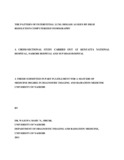The pattern of interstitial lung disease as seen by high resolution computerized Tomography. A cross-sectional study carried out at Kenyatta National Hospital, Nairobi Hospital and M P Shah Hospital
Abstract
Interstitial Lung Disease (ILD) is a major cause of morbidity and mortality worldwide in patients with chronic lung diseases. They account for 8.8% of all chronic lung diseases (I8). Early diagnosis and proper management has been shown to increase the chance of reversibility and prevent further damage to the lung parenchyma. Assessment of pulmonary diseases is therefore of paramount importance for the initial diagnosis, treatment and subsequent follow-up of patients. High Resolution Computerized Tomography (HRCT) is more sensitive in picking subtle lung parenchymal lesions that may not be detectable on radiographs. It offers more detailed information compared to the conventional chest radiography in terms of lesions' characterization and their distribution with the lung hence improving diagnostic accuracy.
Objectives
The main objective of this study was to describe the HRCT pattern of findings of patients with suspected interstitial lung disease at Kenyatta National Hospital (KNH), Nairobi Hospital and MP SHAH Hospital; all situated in Nairobi -Kenya.
Methods
A cross-sectional descriptive study was carried out over a period of 6 months between February and August 2010.All patients aged 18 years and above referred for HRCT of the chest and met the selection criteria during the study period were included in the study after signing an informed consent. They all availed their preliminary plain chest radiographs for reporting. The study was performed on three 16 slice multi-detector CT scanners, Brilliance Model, manufactured by Phillips. Each HRCT done was reviewed by the researcher and a consultant radiologist. The fmdings were recorded in the data collection form for each participant. Data entry preceded analysis that was done using a computer program; SPSS 15. The results were presented in form of tables, graphs and charts followed by a comprehensive discussion.
Results:
During the 6 months study period a total of 101 patients were recruited into the study. The age distribution was between 18 and 100 years with a mean age of 53.6 (SD 19.7) years and a median age of 54 years. The male-female ratio was 1.2: 1. Cough [80.2% (n = 81)] was the commonest presenting complaint followed by dyspnoea (53.5%, n=53) and chest pain [24.8% (n = 25)]. However, majority had a combination of complaints. One-fifth (20.8%, n =21) of patients had other co-existing systemic conditions. Minority of the patients had positive smoking history [17.8 % (n = 18)] or industrial-related occupation history [3% (n=3)]. The clinicians failed to indicate their impression of the cause of illness in one-third of the cases (33.7%, n =34) for which HRCT scans were requested.
Overall, the predominant pattern of involvement on chest HRCT was reticular pattern seen in 56.1 % (n=82) of patients, followed by honey-comb pattern (37.8%, n=82). The lower lung zone was the most commonly affected (68.2%, 95o/oCI, 57-78.1) in the suspected ILD cases followed by the middle lung zone (21.~/o). A combination of both central and peripheral abnormalities were seen in 41.5% (95o/oCI, 30.7-53.4) followed by peripheral abnormalities present in 37.8% (95%CI, 27.3-49.1) of all patterns seen at HRCT. The parenchymal abnormalities were distributed in the central zone only in 2.5% (95%CI, 13-32.2) patients. HRCT demonstrated normal findings in 18.8% cases while plain radiography had 30.7% cases normal reports.
Conclusion
The study demonstrated marked lung parenchymal destruction in most cases; a poor prognostic indicator (29, 30, 49). This could have been due to delayed referral. Early diagnosis is of paramount importance in order to increase the chances of reversing the condition. Primary health care providers should be sensitized on the importance of early referral. HRCT carries a high chance of picking up subtle parenchymal lung lesions as well as defining the lesions and their distribution compared to plain chest radiography. This is important in narrowing the differential diagnosis as well as for pre-biopsy planning. The diagnosis of ILD requires a multidisciplinary approach including a detailed clinical history, physical findings, and laboratory investigations, radiological and histological assessment.
Publisher
University of Nairobi, Kenya

